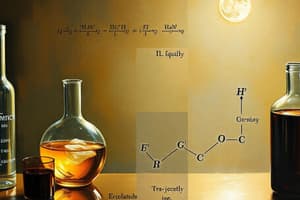Podcast
Questions and Answers
What is the purpose of using chemical formulae instead of words in a chemical equation?
What is the purpose of using chemical formulae instead of words in a chemical equation?
- To confuse the reader
- To make the equation more complex
- To make the equation more lengthy
- To make the equation more concise and useful (correct)
What is the significance of counting the number of atoms of each element on both sides of the arrow in a chemical equation?
What is the significance of counting the number of atoms of each element on both sides of the arrow in a chemical equation?
- To check if the equation is balanced (correct)
- To determine the law of conservation of mass
- To check if the equation is unbalanced
- To calculate the total mass of the reactants
What is the principle behind the law of conservation of mass?
What is the principle behind the law of conservation of mass?
- The total mass of the products is greater than the total mass of the reactants
- The total mass of the reactants is equal to the total mass of the products
- Mass can be created or destroyed in a chemical reaction
- Mass can neither be created nor destroyed in a chemical reaction (correct)
What is the term used to describe a chemical equation that does not have the same number of atoms of each element on both sides of the equation?
What is the term used to describe a chemical equation that does not have the same number of atoms of each element on both sides of the equation?
What is the purpose of balancing a chemical equation?
What is the purpose of balancing a chemical equation?
What is the characteristic of a balanced chemical equation?
What is the characteristic of a balanced chemical equation?
What is the term used to describe a chemical equation that represents a chemical reaction?
What is the term used to describe a chemical equation that represents a chemical reaction?
What is the significance of the arrow (→) in a chemical equation?
What is the significance of the arrow (→) in a chemical equation?
Flashcards are hidden until you start studying
Study Notes
Writing a Chemical Equation
- Chemical equations can be made more concise and useful by using chemical formulae instead of words.
- A chemical equation represents a chemical reaction.
- The equation Mg + O2 → MgO (1.2) is a skeletal chemical equation for the burning of magnesium in air.
- To check if the equation is balanced, count and compare the number of atoms of each element on the LHS and RHS of the arrow.
Balanced Chemical Equations
- The law of conservation of mass states that mass can neither be created nor destroyed in a chemical reaction.
- The total mass of the elements present in the products of a chemical reaction has to be equal to the total mass of the elements present in the reactants.
- In other words, the number of atoms of each element remains the same, before and after a chemical reaction.
- A skeletal chemical equation needs to be balanced to satisfy the law of conservation of mass.
- The equation Zn + H2SO4 → ZnSO4 + H2 (1.3) is a balanced chemical equation, as the number of atoms of each element is the same on both sides of the arrow.
- To balance a chemical equation, count and compare the number of atoms of each element on the LHS and RHS of the arrow.
- Then, adjust the coefficients of the reactants and products to make the number of atoms of each element equal on both sides.
Studying That Suits You
Use AI to generate personalized quizzes and flashcards to suit your learning preferences.




